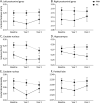Longitudinal Effects of Combination Antiretroviral Therapy on Cognition and Neuroimaging Biomarkers in Treatment-Naive People With HIV
- PMID: 36219802
- PMCID: PMC9519252
- DOI: 10.1212/WNL.0000000000200829
Longitudinal Effects of Combination Antiretroviral Therapy on Cognition and Neuroimaging Biomarkers in Treatment-Naive People With HIV
Abstract
Background and objectives: While combination antiretroviral therapy (cART) has dramatically increased the life expectancy of people with HIV (PWH), nearly 50% develop HIV-associated neurocognitive disorders. This may be due to previously uncontrolled HIV viral replication, immune activation maintained by residual viral replication or activation from other sources, or cART-associated neurotoxicity. The aim of this study was to determine the effect of cART on cognition and neuroimaging biomarkers in PWH before and after initiation of cART compared with that in HIV-negative controls (HCs) and HIV elite controllers (ECs) who remain untreated.
Methods: We recruited 3 groups of participants from the University of Rochester, McGovern Medical School, and SUNY Upstate Medical University: (1) ART treatment-naive PWH; (2) age-matched HCs; and (3) ECs. Participants underwent brain MRI and clinical and neuropsychological assessments at baseline, 1 year, and 2 years. PWH were also assessed 12 weeks after initiating cART. Volumetric analysis and fractal dimensionality (FD) were calculated for cortical and subcortical regions. Mixed effect regressions examined the effect of group and imaging variables on cognition.
Results: We enrolled 47 PWH, 58 HCs, and 10 ECs. At baseline, PWH had worse cognition and lower cortical volumes than HCs. Cognition improved after initiation of cART and remained stable over time. Greater cortical thickness was associated with better cognition at baseline; greater FD of parietal, temporal, and occipital lobes was associated with better cognition at baseline and longitudinally. At baseline, ECs had worse cognition, lower cortical thickness, and lower FD in all 4 lobes and caudate than PWH and HCs. Greater cortical thickness, hippocampal volumes, and FD of frontal, temporal, and occipital lobes were associated with better cognition longitudinally.
Discussion: Initiation of cART in PWH is associated with improvement in brain structure and cognition. However, significant differences persist over time when compared with HCs. Similar trends in ECs suggest that results are due to HIV infection rather than treatment. Stronger associations between cognition and FD suggest this imaging metric may be a more sensitive marker of neuronal injury than cortical thickness and volumetric measures.
© 2022 American Academy of Neurology.
Figures





Similar articles
-
Longitudinal Trajectories of Brain Volume and Cortical Thickness in Treated and Untreated Primary Human Immunodeficiency Virus Infection.Clin Infect Dis. 2018 Nov 13;67(11):1697-1704. doi: 10.1093/cid/ciy362. Clin Infect Dis. 2018. PMID: 29697762 Free PMC article.
-
Effects of Framingham 10-Year Cardiovascular Risk Score and Viral Load on Brain Integrity in Persons With HIV.J Acquir Immune Defic Syndr. 2022 May 1;90(1):79-87. doi: 10.1097/QAI.0000000000002913. J Acquir Immune Defic Syndr. 2022. PMID: 35067658 Free PMC article.
-
Multimodal Investigation of Neuroinflammation in Aviremic Patients With HIV on Antiretroviral Therapy and HIV Elite Controllers.Neurol Neuroimmunol Neuroinflamm. 2022 Feb 9;9(2):e1144. doi: 10.1212/NXI.0000000000001144. Print 2022 Mar. Neurol Neuroimmunol Neuroinflamm. 2022. PMID: 35140142 Free PMC article.
-
Soluble Biomarkers of Cognition and Depression in Adults with HIV Infection in the Combination Therapy Era.Curr HIV/AIDS Rep. 2021 Dec;18(6):558-568. doi: 10.1007/s11904-021-00581-y. Epub 2021 Nov 15. Curr HIV/AIDS Rep. 2021. PMID: 34780037 Free PMC article. Review.
-
Role of neuroimaging in HIV-associated neurocognitive disorders.Semin Neurol. 2014 Feb;34(1):89-102. doi: 10.1055/s-0034-1372346. Epub 2014 Apr 8. Semin Neurol. 2014. PMID: 24715492 Free PMC article. Review.
Cited by
-
Chronic brain damage in HIV-infected individuals under antiretroviral therapy is associated with viral reservoirs, sulfatide release, and compromised cell-to-cell communication.Cell Mol Life Sci. 2023 Apr 4;80(4):116. doi: 10.1007/s00018-023-04757-0. Cell Mol Life Sci. 2023. PMID: 37016051 Free PMC article.
-
Characteristics of cortical thickness in treated HIV-infected individuals with and without cognitive impairment.Eur J Med Res. 2025 Apr 15;30(1):281. doi: 10.1186/s40001-025-02555-x. Eur J Med Res. 2025. PMID: 40229906 Free PMC article.
-
Mechanisms and treatments of methamphetamine and HIV-1 co-induced neurotoxicity: a systematic review.Front Immunol. 2024 Aug 19;15:1423263. doi: 10.3389/fimmu.2024.1423263. eCollection 2024. Front Immunol. 2024. PMID: 39224601 Free PMC article.
-
Initiation of combined antiretroviral therapy confers suboptimal beneficial effects on neurovascular function in people with HIV.Front Neurol. 2023 Aug 31;14:1240300. doi: 10.3389/fneur.2023.1240300. eCollection 2023. Front Neurol. 2023. PMID: 37719766 Free PMC article.
-
The association between rapid antiretroviral therapy initiation and brain structure and function based on multimodal magnetic resonance imaging in HIV-positive men who have sex with men.BMC Infect Dis. 2025 Jan 8;25(1):41. doi: 10.1186/s12879-024-10397-x. BMC Infect Dis. 2025. PMID: 39780061 Free PMC article.
References
Publication types
MeSH terms
Substances
Grants and funding
LinkOut - more resources
Full Text Sources
Medical
